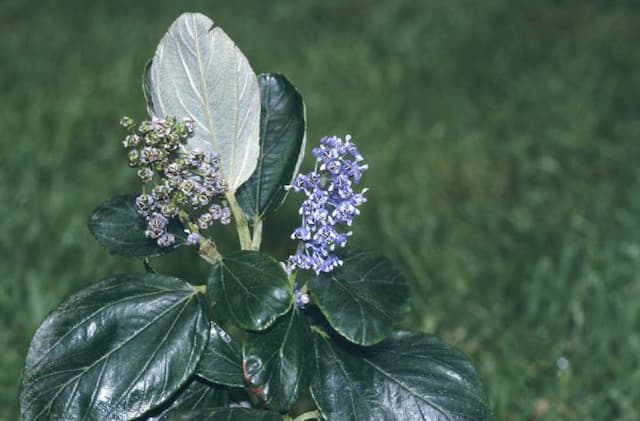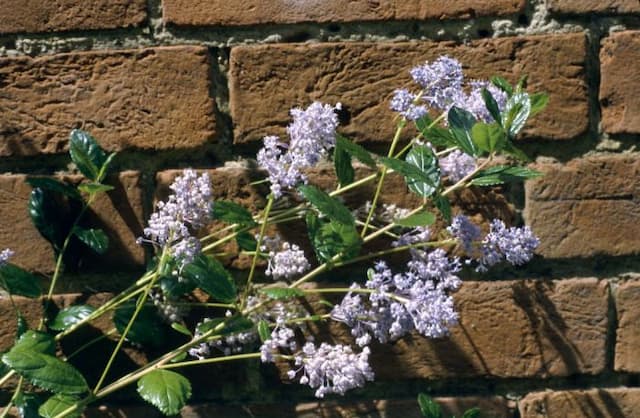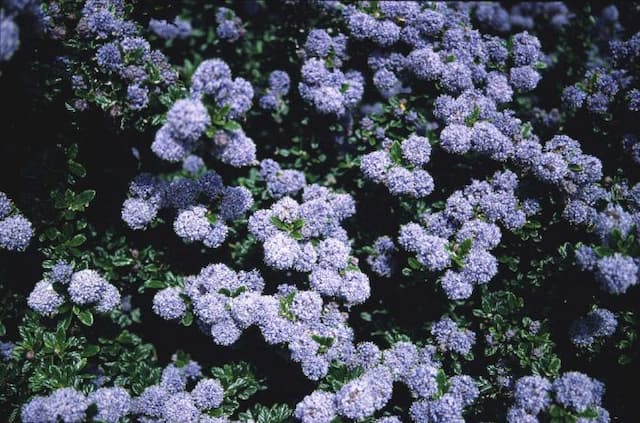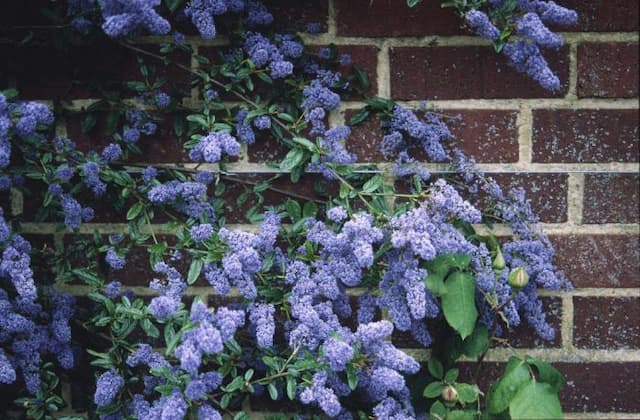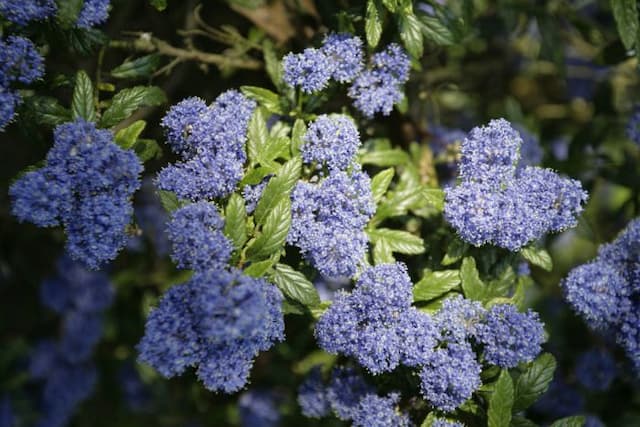California Lilac Ceanothus 'Burkwoodii'

ABOUT
The Ceanothus 'Burkwoodii', commonly known as California lilac, is an attractive evergreen shrub with a dense and rounded habit. Its foliage consists of small, glossy green leaves that provide a lush and vibrant backdrop throughout the year. In spring and early summer, the plant is adorned with clusters of tiny, powder blue to deep blue flowers. These flowers are quite fragrant and are arranged in conical or rounded groupings that can cover the shrub, offering a showy display that is highly appealing to bees, butterflies, and birdlife. The overall visual effect of the California lilac in bloom is that of a blue haze enveloping the plant, creating a striking feature in any garden. The stems and branches of the shrub are sleek, with a bark that may appear reddish when young but matures to a more subdued tone over time.
About this plant
 Names
NamesFamily
Rhamnaceae
Synonyms
Burkwood's Ceanothus, Burkwood's California Lilac
Common names
Ceanothus 'Burkwoodii'.
 Toxicity
ToxicityTo humans
The California lilac, commonly referred to as Ceanothus 'Burkwoodii', is not known to be toxic to humans. Ingesting any part of the plant is unlikely to cause poisoning or severe adverse health effects.
To pets
The California lilac, known in botanical terms as Ceanothus 'Burkwoodii', is not recognized as a toxic plant to pets. Consuming parts of this shrub should not result in poisoning or serious health consequences for domestic animals such as dogs and cats.
 Characteristics
CharacteristicsLife cycle
Perennials
Foliage type
Evergreen
Color of leaves
Dark green
Flower color
Blue
Height
6 feet (1.83 meters)
Spread
6 feet (1.83 meters)
Plant type
Shrub
Hardiness zones
7
Native area
North America
Benefits
 General Benefits
General Benefits- Ornamental Appeal: Ceanothus 'Burkwoodii', commonly known as Burkwood Ceanothus, features attractive dark green foliage and displays profuse clusters of fragrant blue flowers in the spring.
- Attracts Pollinators: The flowers of the Burkwood Ceanothus are nectar-rich and attract a variety of pollinators, including bees, butterflies, and hummingbirds, which help in the pollination of other plants.
- Drought Tolerance: Once established, this plant is quite drought-tolerant, making it suitable for water-wise gardens and reducing the need for frequent watering.
- Low Maintenance: This shrub requires minimal care once established, making it an ideal choice for gardeners seeking low-maintenance landscaping options.
- Erosion Control: Burkwood Ceanothus's root system helps stabilize slopes and prevent soil erosion, making it helpful for hillside plantings and naturalized areas.
- Habitat Enhancement: It provides shelter and nesting sites for birds, benefiting the local ecosystem by enhancing habitat diversity.
- Seasonal Interest: Aside from its spring blooms, the Burkwood Ceanothus offers year-round interest with its evergreen foliage, adding color to the garden in all seasons.
- Fast Growth: This plant is known for its relatively fast growth rate, which allows for quick establishment and filling in of garden spaces.
- Versatility: It can be used in different garden design styles, including formal, cottage, Mediterranean, and naturalistic landscapes.
- Privacy Screening: Due to its dense growth habit, Burkwood Ceanothus can be used as a privacy screen or hedge to block unwanted views or define property boundaries.
 Medical Properties
Medical Properties- This plant is not used for medical purposes
 Air-purifying Qualities
Air-purifying QualitiesThis plant is not specifically known for air purifying qualities.
 Other Uses
Other Uses- Ceanothus 'Burkwoodii', commonly known as California Lilac, can be used as a natural dye for fabrics, providing hues of green and yellow depending on the mordant used.
- In permaculture gardens, California Lilac serves as a nitrogen fixer, improving soil fertility and benefiting nearby plants.
- Its dense growth habit makes California Lilac ideal for erosion control on slopes and banks, securing the soil effectively.
- California Lilac is often chosen as a habitat plant for native butterflies and insects, supporting local biodiversity.
- The wood of California Lilac is sometimes utilized in small-scale woodworking projects, such as for making handles and crafts.
- Though not a primary choice for fodder, California Lilac can act as an emergency feed for livestock during extreme food shortages.
- Landscape designers use California Lilac for creating natural privacy screens or hedges due to its thick foliage.
- In floral arrangements, branches of California Lilac can add a wild, naturalistic touch with their vibrant blue flowers.
- Sustainable landscape practices can incorporate California Lilac as part of fire-resistant planting schemes in fire-prone regions.
- California Lilac's fast-growing nature makes it a candidate for use in reforestation or wildland restoration projects, helping to reintroduce native flora.
Interesting Facts
 Feng Shui
Feng ShuiThe California Lilac is not used in Feng Shui practice.
 Zodiac Sign Compitability
Zodiac Sign CompitabilityThe California Lilac is not used in astrology practice.
 Plant Symbolism
Plant Symbolism- Resilience: Ceanothus 'Burkwoodii', commonly known as the California lilac, is known for its ability to survive in dry conditions, representing the quality of resilience and enduring through challenges.
- Hope: The bright blue flowers of the California lilac can symbolize a sense of hope and expectation as they often signal the arrival of spring after a long winter.
- Renewal: As a plant that blooms vibrantly, it is often associated with renewal and the cycle of rebirth and regeneration.
- Beauty: With its lush flowers, the California lilac is a symbol of natural beauty, reminding us to appreciate the aesthetic pleasures of the world.
- Protection: Some Native American tribes believe that Ceanothus is a protective plant, and its presence would safeguard them from harm.
 Water
WaterCalifornia Lilac should be watered deeply but infrequently, with more care given during its first growing season to establish an extensive root system. Once established, this plant is quite drought tolerant, so watering can be reduced. Generally, watering once a week with approximately 1 to 1.5 gallons of water per plant should suffice, depending on soil conditions and climate. In hotter, dryer periods, twice weekly may be necessary, while in cooler, wetter climates, less frequent watering may be required. It’s important to ensure that the soil drains well to avoid waterlogging, which can lead to root rot.
 Light
LightCalifornia Lilac thrives best in full sunlight. The ideal spot for this plant would be an area where it receives at least six hours of direct sunlight daily. Partial shade is acceptable, particularly in very hot climates, but too much shade will reduce blooming and may lead to leggy growth.
 Temperature
TemperatureCalifornia Lilac prefers moderate to warm climates and can generally tolerate temperatures ranging from 10 to 100 degrees Fahrenheit. The ideal temperature range for promoting healthy growth and flowering is between 50 and 85 degrees Fahrenheit. It's important to protect the plant from frost, as temperatures below 10 degrees Fahrenheit can damage or kill it.
 Pruning
PruningPrune California Lilac to maintain shape and promote bushier growth. The best time to prune is immediately after the plant has finished blooming in late spring or early summer. Deadheading spent flowers can also encourage a second bloom. Moderate pruning once a year is typically enough; cutting back up to one-third of the oldest stems to the ground can rejuvenate the plant.
 Cleaning
CleaningAs needed
 Soil
SoilThe California Lilac, or Ceanothus 'Burkwoodii', thrives in well-draining soil with a pH ranging from slightly acidic to neutral (pH 5.5 to 7). The ideal soil mix should be rich in organic matter, such as a combination of loam, peat, and sand to improve drainage and fertility.
 Repotting
RepottingCalifornia Lilac rarely needs repotting; it's typically planted directly in the landscape. However, if grown in a container, it may be repotted every 2-3 years to refresh the soil and accommodate root growth.
 Humidity & Misting
Humidity & MistingCalifornia Lilac is adaptable but prefers moderate humidity levels; it tolerates coastal conditions well which often have higher humidity.
 Suitable locations
Suitable locationsIndoor
Bright light with some direct sun; ensure good air flow.
Outdoor
Full sun, well-drained soil, shelter from strong winds.
Hardiness zone
7-10 USDA
 Life cycle
Life cycleThe life cycle of Ceanothus 'Burkwoodii', commonly known as the Burkwood Ceanothus, begins with seed germination, which occurs when environmental conditions such as temperature and moisture levels are conducive. The seedling emerges and establishes a root system while developing true leaves, entering the vegetative growth phase where it increases in size and strength. As the plant matures, it enters the flowering stage in late spring or early summer, producing clusters of fragrant, small bluish-purple flowers which attract pollinators. Following pollination, the plant develops fruit in the form of small, hard capsules containing seeds, which are dispersed by various means to create new plants. The Burkwood Ceanothus is a perennial shrub that can live for many years, going through the flowering and fruiting cycle annually. Seasonal changes induce periods of dormancy, especially in colder climates, during which the plant conserves energy until favorable growth conditions return.
 Propogation
PropogationPropogation time
Spring-early summer
Ceanothus 'Burkwoodii', also known as California lilac, is commonly propagated through semi-hardwood cuttings. The best time to take cuttings is in late summer. A cutting should be about 4 to 6 inches (10 to 15 centimeters) long with several leaves. It's essential to use a sharp, sterilized cutting tool to prevent infection. After cutting, dip the end in rooting hormone to encourage root growth and plant it in a pot with a mixture of peat and perlite. The pot should be kept in a warm location with indirect sunlight. Keeping the soil moist but not waterlogged is crucial, and roots typically will form within a few weeks. After rooting, the new plants can be gradually acclimated to outdoor conditions and eventually transplanted into the garden.
